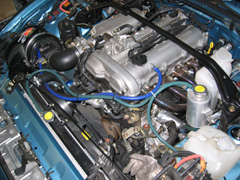OK, went and looked this up on wiki. Whether or not wiki is a reliable source or not is a different matter, but here we go...
http://en.wikipedia.org/wiki/Cold_air_intake[quote=Wikipedia]All cold air intakes operate on the principle of increasing the amount of oxygen available for combustion with fuel. Because cooler air has more density for a given volume, cold air intakes generally work by introducing cooler air from outside the hot engine bay.[/quote]
Now, I would say that the RAI adheres to this principle. You're increasing oxygen to the engine since the air is coming straight from the front and into the throttle body.
The only reason I can think of why this wouldn't be correct would be because of too turbulent fluid flow. I don't remember much out of my university physics, but I would guess that a fluid is most turbulent when its cross sectional area is changed suddenly. Have enough fluid at the area of entry, and it'll push the turbulent air in line and in the right direction down the new cross sectional area. Reduce the length of it, and you might reduce the ability for the air to streamline itself.
I guess this kinda explains why the RAI has better high end performance, because the air is coming in at such a high velocity that it doesn't really get a chance to become turbulent because the next bit of air is already pushing it in, but I don't quite get how lower speeds can result in worse performance than stock or a CAI.
Anyone care to add/correct me? I'm keen to see what you all reckon.












